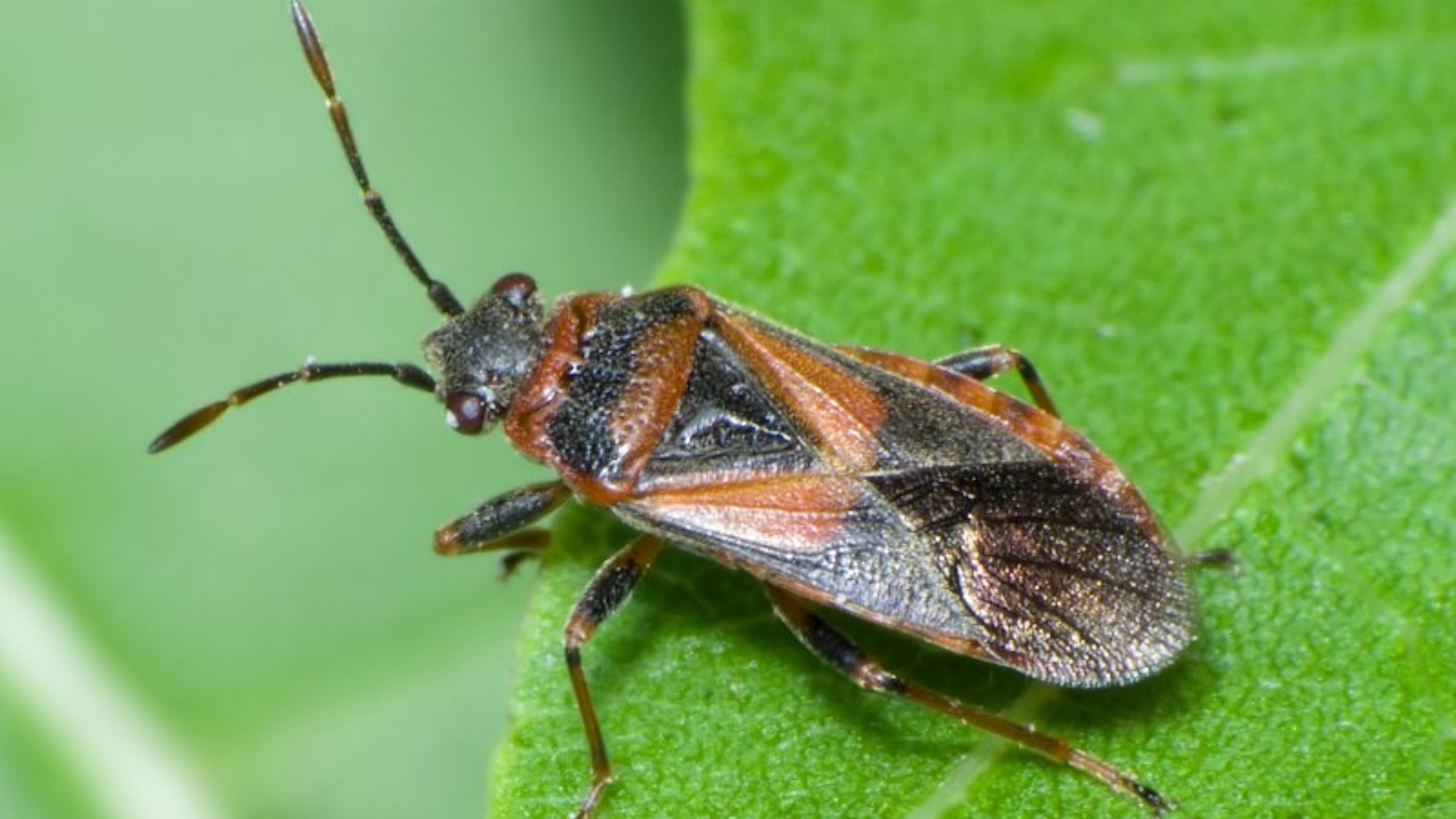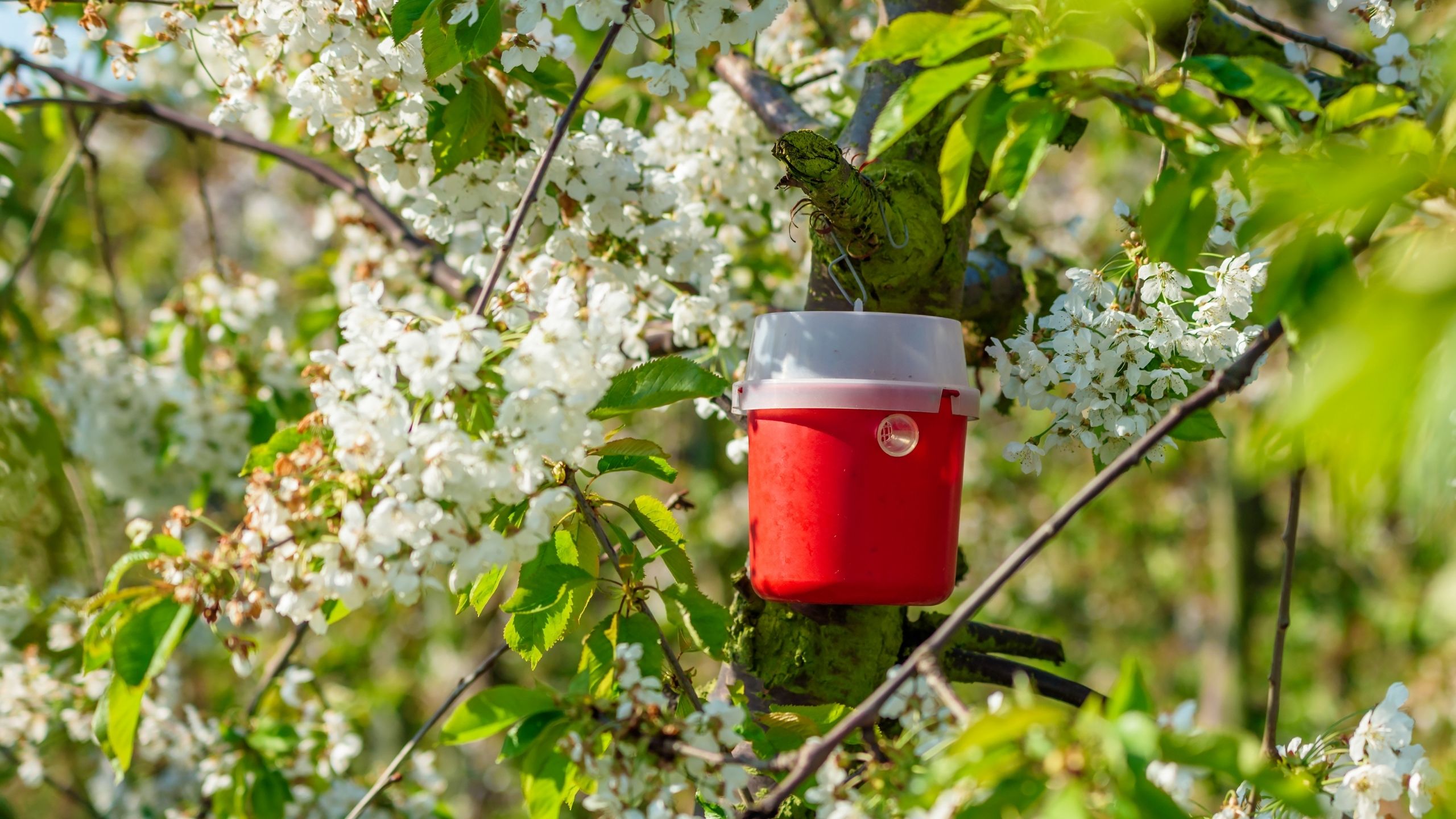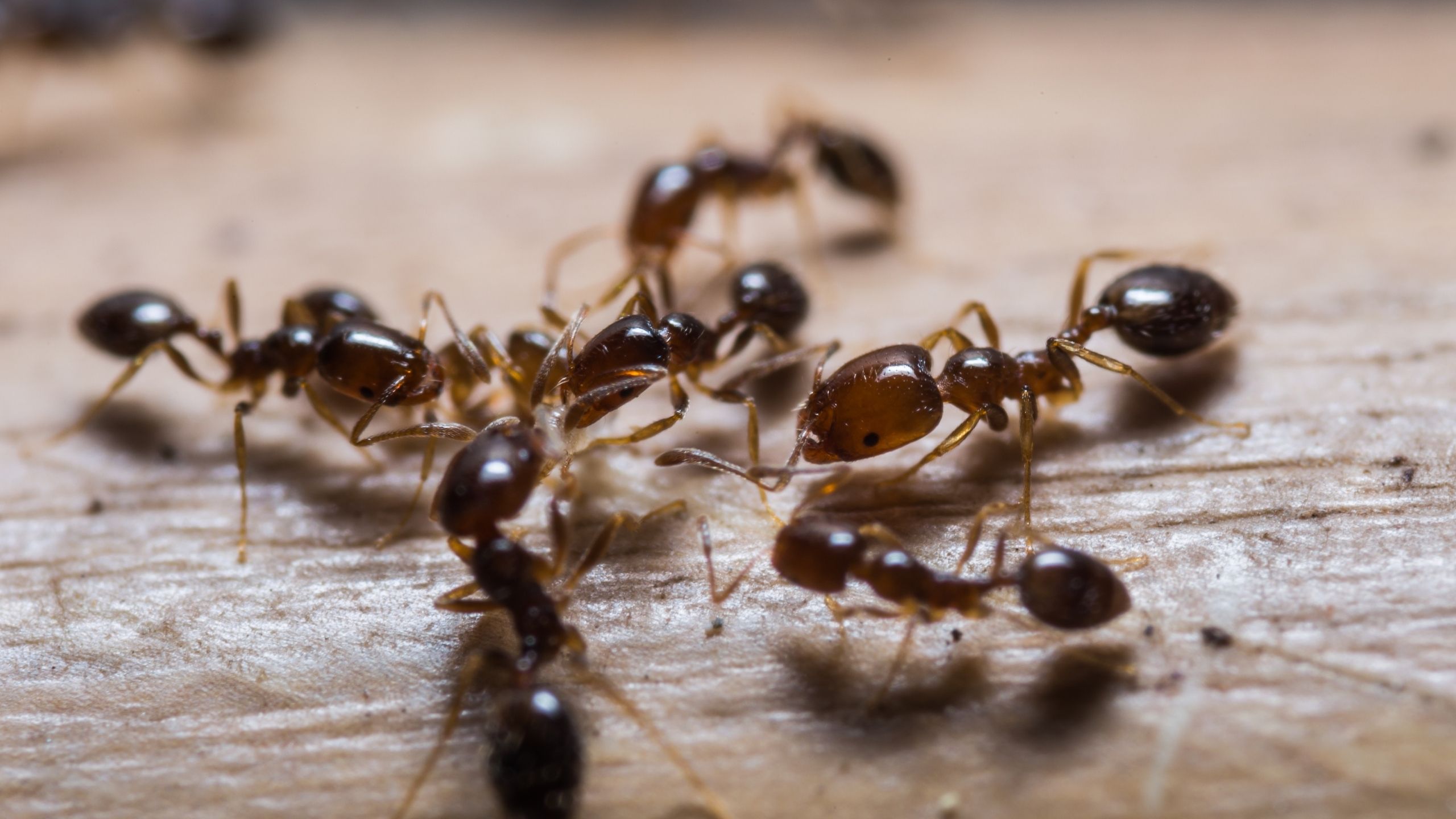Brown Marmorated Stink Bug Management for Fruits and Vegetables in Utah
August 2018
Lori Spears, Extension Entomologist (No longer at USU) • Diane Alston, Extension Entomologist (No longer at USU) • Marion Murray, Extension IPM Specialist
Quick Facts
- Brown marmorated stink bug (BMSB) is an invasive agricultural and nuisance pest from eastern Asia.
- BMSB has a broad host range that includes fruits, vegetables, nuts, and ornamentals.
- During the winter, BMSB adults will congregate in and on buildings.
- BMSB was first detected in the U.S. in the late 1990s. In 2012, it was detected in Utah and feeding damage was first reported on some fruits and vegetables in 2017.
- Monitoring can aid in assessing the need for action. Monitoring recommendations include traps, visual surveys, and beat sheet samples.
- BMSB is a perimeter-driven pest, so border sprays are useful in multiple cropping systems.

The brown marmorated stink bug (BMSB; Halyomorpha halys Stål) (Hemiptera: Pentatomidae) (Figs. 1-4) is an economically important nuisance and agricultural pest that invaded North America from eastern Asia in the late 1990s. BMSB congregates in and on buildings during the winter, and is known to attack over 170 plant species, including fruit, vegetable, and nut crops, as well as herbaceous and woody ornamentals (see https://extension.usu.edu/pests/caps/bmsb-host-plants for a list of known host plants in Utah). Ornamental hosts in urbanized areas are important to building BMSB populations in the early summer before they move into agricultural crops. BMSB uses a stylet (needlelike mouthpart) to feed on the reproductive structures of host plants, but will also feed on bark, stems, and foliage.
BMSB was first detected in Utah in 2012. Reproducing populations (adults and immature life stages) can be found in Utah, Salt Lake, Davis, Weber, and Box Elder counties, and a few adult bugs have been detected in Cache County. In 2017, BMSB feeding damage was first reported on some fruits and vegetables in multiple counties.
This fact sheet emphasizes identification, monitoring, and management of BMSB. For more general information about BMSB, consult the Utah State University fact sheet “Brown Marmorated Stink Bug” and the references at the end of this fact sheet.
It is important to accurately identify and monitor BMSB and feeding damage before making any treatment. If you are unable to make a definite identification, contact the Utah Plant Pest Diagnostic Lab at Utah State University for help.
Identification
Adults are shield-shaped, and about 5/8 inch long and 1/2 inch wide (Figs. 1 and 2). The term “marmorated” refers to the brown marbled pattern on the adult bodies. Their antennae, legs, and posterior edge of the back have distinct light and dark banding patterns. BMSB “shoulders” are rounded and smooth. Adults have undersides that are light gray or tan.
Eggs are barrel-shaped, 1/16 inch wide, and translucent to white in color (Fig. 3). As eggs mature, dark triangular-shaped spots become visible. Eggs are typically laid on the underside of leaves and in masses of approximately 20-30 (average of 28).
Nymphs vary in color, depending on age. Newly hatched nymphs are tick-like in appearance, have yellow-red backs with black stripes, and tend to huddle near the egg mass (Fig. 3). As nymphs mature, they disperse from the egg mass, darken in color, develop wing pads (immature wings), and begin to look similar to adults in color and size (Fig. 4). Nymphs range in size from 1/10 to 1/2 an inch.
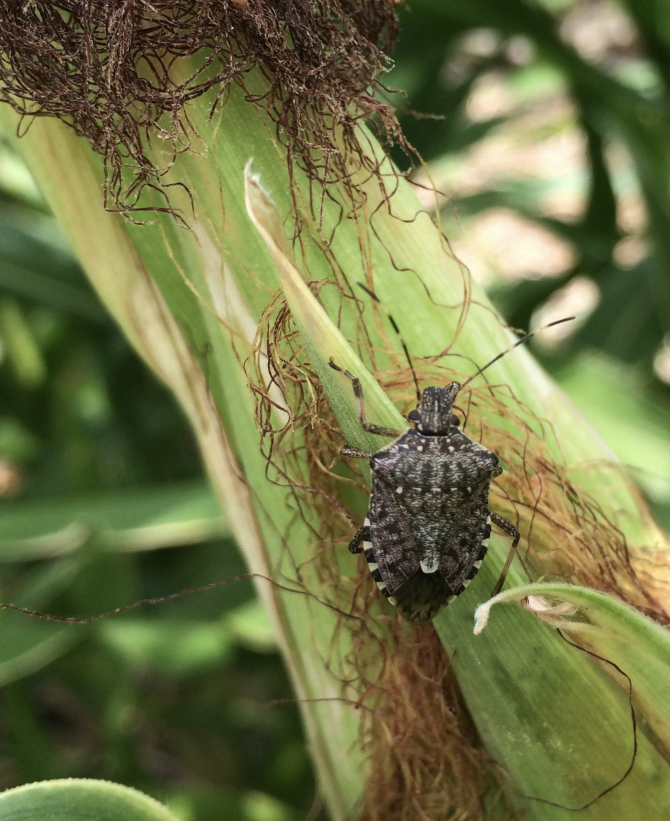

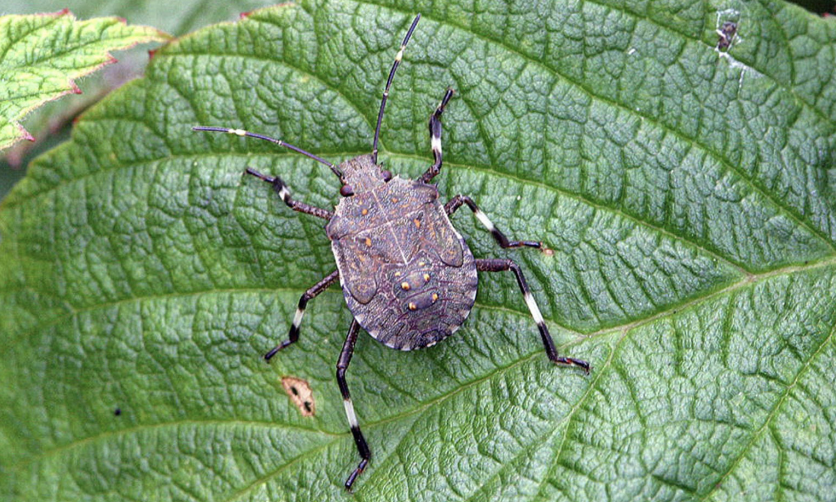
Feeding Injury
Feeding can cause necrotic (dark colored) lesions, pits, depressions, cat-facing (deformities), and gummosis (peach, nectarine, and apricot) on fruits; feeding in fruit flesh causes corky, discolored areas (Figs. 5-7). BMSB feeding can even cause some fruit structures, especially nuts, to abort. Note that damage may not appear until 1-2 weeks after feeding has occurred, and possibly later for fruit stored at cold temperatures.



Monitoring
Traps
Mass trapping of BMSB has not been shown to be an effective control option, but pheromone traps should be used to estimate population levels and aid in control decisions. Traps should be placed along the field edge so that BMSB can be intercepted as it moves from urban and forested habitats into the agricultural crop. Where damage has been detected previously, consider placing traps in the interior of the orchard or field as well. Traps should be checked at least once weekly from May through October. Two of the most effective traps that are currently available are the pyramid and the sticky panel traps.
Pyramid traps (Fig. 8) are typically black, stand 4 ft. tall, and consist of an inverted clear plastic container with an entry cone that is attached with a bungee cord. An example of a pyramid trap is available from AgBio, Inc. (Dead-Inn™ traps). To prevent escape and kill trapped bugs, add a small piece (6 in2 ) of a long-lasting insecticide net (Vestergaard) or an insecticide-laced strip (Vaportape II [Hercon]).- Sticky panted traps (Fig. 9) are comprised of a doublesided clear sticky panel (6” x 9”, available from Trécé) mounted on a wood stake (1” x 1” x 5’). The sticky panels should be replaced every 4 weeks (or sooner if >50% of the surface area is covered by insects or debris).

Fig. 8. Pyramid trap. 
Fig. 9. Sticky panel trap.
Lures
All traps should be paired with a lure. A few different types of commercial lures are available, but research in Utah has demonstrated that more stink bugs are captured with the Trécé Inc. dual lure, comprised of both a BMSB aggregation pheromone (murgantiol) and the synergist methyl decatrienoate (MDT) (Leskey et al. 2012). The dual lure should be replaced at 12-week intervals.
Other Monitoring Recommendations
Visual surveys and beat sheets (shaking crop plant over a sheet or cloth tray) can also be useful to detect BMSB. For orchard monitoring, note that BMSB will often move to the upper canopy of fruit trees to feed. Visual monitoring should also include fruit inspections for damage, including internal injury (especially in peach and nectarine), since damage on the surface of some types of fruits may not be visible.
Management
Unfortunately, BMSB is a challenging insect to manage. Both nymphs and adults damage crops, and adults have a tough exoskeleton that is covered with a waxy, water-repellant cuticle that can help protect them from pesticide applications. Further, adults have a strong dispersal capacity, enabling them to easily invade previously-treated areas. Adults can theoretically fly more than 70 miles per day, although most adults fly short distances (Wiman et al. 2014; Lee and Leskey 2015). Ornamental hosts in urbanized areas are important to building BMSB populations in the early summer before they move into agricultural crops. Even nymphs, which are wingless, are relatively mobile due to strong walking capacity (Lee et al. 2014).
Due to challenges with managing BMSB, growers in the mid-Atlantic region with BMSB infestations are relying on weekly, season-long applications of broad-spectrum insecticides, as integrated management programs are still under development. Keep in mind, however, that broad-spectrum insecticides are costly, risk development of pest resistance, can be harmful to beneficial insects, and may contribute to secondary pest outbreaks.
Treatment Threshold in Apple
Research has shown that a cumulative threshold of 10 adults per trap indicates the need for an insecticide spray to reduce fruit injury, and continued accumulations exceeding 10 adults per trap would trigger successive sprays as the season progresses (Short et al. 2016). Treatment thresholds have only been developed in apple.
Period of Risk
BMSB adults emerge from overwintering sites in response to a photoperiod (day length) of 12.7-13.5 hours (Nielsen et al. 2016; Nielsen et al. 2017), which translates to around mid-April in Utah. After emergence, egg-laying starts at 135 degree days (DD) (base 57.2 °F), and then this first generation matures into adults after an additional 964 DDs (Wilson et al. 2018) (Table 1). Keep in mind that both adults and nymphs damage crops; therefore, accurate timing of sprays is essential to reduce crop injury.
- Peach, nectarine, and apricot are susceptible to BMSB feeding soon after fruit set until harvest, so BMSB management should be considered from shuck-split onward.
- Apple and pear are primarily at risk from early summer onward.
- For sweet or tart cherry, research in Utah has shown that BMSB will feed on buds and flowers, yet it is unlikely that BMSB will be present in cherry orchards until around the time of pit hardening or color change.
- Berries and grapes are susceptible to BMSB feeding after bud development.
- Sweet corn and fruit vegetable crops are vulnerable from tasseling onward, and once fruits have developed, respectively.
|
Location
|
1st Overwintered 13.5 hr day (biofix) |
Egg Laying Begins 170 DD |
New (Summer) Generation 1134 DD |
|---|---|---|---|
| River Heights, UT (Cache County) | 18-19 April | 7-13 June | 11-29 August |
| Kaysville, UT (Davis County) | 19-20 April | 29 May - 7 June | 25 July - 2 August |
| Payson, UT (Utah County) | 20-21 April | 2-7 June | 29 July - 4 August |
| Leeds, UT (Washington County) | 24-25 April | 9-24 May | 30 June - 6 July |
Chemical Control
BMSB populations are typically highest on field edges, and research has shown that border sprays can be successful in controlling BMSB in multiple cropping systems (Blaauw et al. 2015; Leskey and Nielsen 2018). In addition to the outside edge, treatment of the first full row of the crop border can provide additional crop protection. Another treatment option is two alternate-row-middle (ARM) sprays (i.e., applying insecticides to only one side of the tree or crop) with 7 days between each spray. Whole-block sprays should be reserved for when BMSB has been detected in traps placed in the orchard or field interior, and later in the season when BMSB feeds intensively before moving to overwintering sites.
Since overwintered adults are more susceptible to insecticides than the summer generation(s), reserve the most efficient products (Table 2) for later in the season. In general, BMSB populations in orchards and fields tend to be highest in August. Further, BMSB will often move to the upper canopy of fruit trees to feed, so target insecticide applications toward the top of trees.
Table 2. The following is a list of insecticides that have demonstrated efficacy against BMSB (Wilson et al. 2018). Note that this list is not exhaustive for every labeled product or active ingredient. Always follow the specific label restrictions for the target crop, including the preharvest interval (PHI) and re-entry interval (REI). Always read, understand, and follow label directions before using any pesticide.
| Product Name(s) | Active Ingredient(s) | Mode of Action* | Relative Efficacy Against BMSB |
|---|---|---|---|
| LannateR, NudrinR | methomyl | 1A - Carbamate | Excellent |
| Danitol 2.4 ECR | fenpropathrin | 3A - Pyrethroid | Excellent |
| Pounce 25 WPR | permethrin | 3A - Pyrethroid | Excellent |
| Warrior IIR, Lambda-CyR, SilencerR | lamda-cyhalothrin | 3A - Pyrethroid | Excellent |
| Actara | thiamethoxam | 4A - Neonicotinoid | Excellent |
| Admire Pro, Alias, Wrangler | imidacloprid | 4A - Neonicotinoid | Good |
| Assail | acetamiprid | 4A - Neonicotinoid | Good |
| Scorpion 35 SL, Venom | dinotefuran | 4A - Neonicotinoid | Excellent |
| Belay | clothianidin | 4A - Neonicotinoid | Good |
| Endigo ZCR | lamda-cyhalothrin & thiamethoxam | 3A - Pyrethroid, 4A - Neonicotinoid | Excellent |
| Leverage 360R | beta-cyfluthrin & imidacloprid | 3A - Pyrethroid, 4A - Neonicotinoid | Excellent |
| Voliam XpressR | lamda-cyhalothrin & chlorantraniliprole | 3A - Pyrethroid, 8 - Diamide | Good |
| Aza-DirectO and others | botanical | Not classified | Good |
References & Further Reading
- Bergh, C., A. Acebes-Doria, T. Leskey, et al. 2016. Integrated pest management for brown marmorated stink bug in orchard crops. Produced by the Brown Marmorated Stink Bug SCRI CAP Orchard Crop Commodity Team in conjunction with the Northeastern IPM Center.
- Blaauw, B.R., D. Polk, and A.L. Nielsen. 2015. IPM-CPR for peaches: incorporating behaviorally-based methods to manage Halyomorpha halys and key pests in peach. Pest Management Science 71: 1513-1522.
- Cannon, C., D.G. Alston, C. Nischwitz, L.R. Spears, and C. Burfitt. 2016. Invasive fruit pest guide for Utah: insect and disease identification, monitoring and management. Utah State University Extension.
- Holthouse, M.C., D.G. Alston, L.R. Spears, and E. Petrizzo. 2017. Brown marmorated stink bug [Halyomorpha halys (Stål)]. Fact Sheet ENT-144-17. Utah State University Extension.
- Kuhar, T., R. Morrison, T. Leskey, et al. 2016. Integrated pest management for brown marmorated stink bug in vegetables. Produced by the Brown Marmorated Stink Bug SCRI CAP Vegetable Commodity Team in conjunction with the Northeastern IPM Center.
- Lee, D.H., and T.C. Leskey. 2015. Flight behavior of foraging and overwintering brown marmorated stink bug, Halyomorpha halys (Hemiptera: Pentatomidae). Bulletin of Entomological Research 105: 566-573.
- Leskey, T.C., S.E. Wright, B.D. Short, et al. 2012. Development of behaviorally based monitoring tools for the brown marmorated stink bug in commercial tree fruit orchards. Journal of Entomological Science 47: 76-85.
- Leskey, T.C., and A.L. Nielsen. 2018. Impact of the invasive brown marmorated stink bug in North America: history, biology, ecology, and management. Annual Review of Entomology 63: 599-618.
- Nielsen, A.L., G.C. Hamilton, and D. Matadha. 2008. Developmental rate estimation and life table analysis for Halyomorpha halys (Hemiptera: Pentatomidae). Environmental Entomology 37: 348-355.
- Nielsen, A.L., S. Chen, and S.J. Fleischer. 2016. Coupling developmental physiology, photoperiod, and temperature to model phenology and dynamics of an invasive Heteropteran, Halyomorpha halys. Frontiers in Physiology 7: 165. doi: 10.3389%Fphys.2016.00165
- Nielsen, A.L., S. Fleischer, G.C. Hamilton, et al. 2017. Phenology of brown marmorated stink bug described using female reproductive development. Ecology and Evolution 7: 6680-6690. doi: 10.1002%2Fece3.3125
- Short, B.D., A. Khrimian, and T.C. Leskey. 2016. Pheromone-based decision support tools for management of Halyomorpha halys in apple orchards: development of a trap-based treatment threshold. Journal of Pest Science doi: 10.1007/s10340-016-0812-1
- Spears, L.R., R. Davis, D. Alston, R. Ramirez, E. Brennan, and C. Cannon. 2016. First detector guide to invasive insects. Utah State University Extension.
- Wilson, J., L. Gut, M. Haas, M. Grieshop, K. Poley, and W. Shane. 2018. Michigan State University.
- Wiman, N.G., V.M. Walton, P.W. Shearer, S.I. Rondon, and J.C. Lee. 2014. Factors affecting flight capacity of brown marmorated stink bug, Halyomorpha halys (Hemiptera: Pentatomidae). Journal of Pest Science 88: 37–47.
- Wiman, N., V. Walton, C. Rodriguez-Saona, et al. 2016. Integrated pest management for brown marmorated stink bug in small fruit. Produced by the Brown Marmorated Stink Bug SCRI CAP Orchard Crop Commodity Team in conjunction with the Northeastern IPM Center.
- University of Massachusetts Extension. Brown Marmorated Stink Bug Management. 2018.
Funding
Funding for this publication was made possible by the National Institute of Food and Agriculture, U.S. Department of Agriculture, Specialty Crop Research Initiative (under award number 2016- 51181-25409), U.S. Department of Agriculture, Animal and Plant Health Inspection Service, Plant Protection and Quarantine (USDA-APHIS-PPQ) (under award number 201699-00001), USU Extension, and the Utah Agricultural Experiment Station.
Related Research







